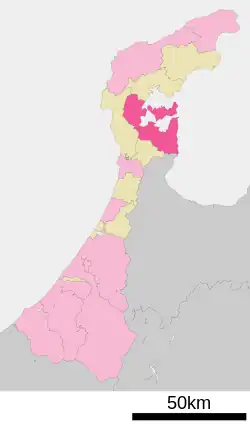Nanao
七尾市 | |
|---|---|
 Nanao City Hall | |
 Flag  Seal | |
 Location of Nanao in Ishikawa Prefecture | |
 Nanao | |
| Coordinates: 37°2′35.3″N 136°58′2.8″E / 37.043139°N 136.967444°E | |
| Country | Japan |
| Region | Chūbu (Hokuriku) |
| Prefecture | Ishikawa Prefecture |
| Government | |
| • Mayor | Yoshitaka Chatani (since November 2020) |
| Area | |
| • Total | 318.32 km2 (122.90 sq mi) |
| Population (March 31, 2022) | |
| • Total | 49,660 |
| • Density | 160/km2 (400/sq mi) |
| Time zone | UTC+9 (Japan Standard Time) |
| Phone number | 0767-53-1111 |
| Address | 1-25 Sodegaemachi, Nanao-shi, Ishikawa-ken 926-8611 |
| Climate | Cfa |
| Website | www |
| Symbols | |
| Bird | Common gull |
| Flower | Azalea |
| Tree | Pine |

Nanao (七尾市, Nanao-shi) is a city located in Ishikawa Prefecture, Japan. As of 31 March 2022, the city had an estimated population of 49,660 people in 21,809 households.[1] The total area of the city was 318.32 square kilometres (122.90 sq mi). Nanao is the fifth largest city by population in Ishikawa, behind Kanazawa, Hakusan, Komatsu, and Kaga.
Geography
Nanao occupies the southeastern coast of Noto Peninsula and is bordered by the Sea of Japan on the east and north, and Toyama Prefecture to the south. Parts of the city are within the borders of the Noto Hantō Quasi-National Park. The name "Nanao" (七尾) literally means "Seven Tails" and is said to be named for the seven mountain ridges (or "tails") surrounding Nanao that are visible when viewed from Joyama (七尾城山), site of the city's historical castle ruins. These ridges are called Kikuo (菊尾, "Chrysanthemum Tail"), Kameo (亀尾, "Turtle Tail"), Matsuo (松尾, "Pine Tail"), Torano'o (虎尾, "Tiger Tail"), Takeo (竹尾, "Bamboo Tail"), Umeo (梅尾, "Plum Tail"), and Tatsuo (龍尾, "Dragon Tail").
Neighbouring municipalities
Climate
Nanao has a humid continental climate (Köppen Cfa) characterized by mild summers and cold winters with heavy snowfall. The average annual temperature in Nanao is 13.7 °C. The average annual rainfall is 2392 mm with September as the wettest month. The temperatures are highest on average in August, at around 26.0 °C, and lowest in January, at around 2.9 °C.[2]
| Climate data for Nanao (1991−2020 normals, extremes 1978−present) | |||||||||||||
|---|---|---|---|---|---|---|---|---|---|---|---|---|---|
| Month | Jan | Feb | Mar | Apr | May | Jun | Jul | Aug | Sep | Oct | Nov | Dec | Year |
| Record high °C (°F) | 16.8 (62.2) |
21.9 (71.4) |
25.1 (77.2) |
30.1 (86.2) |
31.7 (89.1) |
32.4 (90.3) |
37.4 (99.3) |
38.1 (100.6) |
37.1 (98.8) |
31.9 (89.4) |
25.6 (78.1) |
21.4 (70.5) |
38.1 (100.6) |
| Mean daily maximum °C (°F) | 6.0 (42.8) |
6.8 (44.2) |
10.6 (51.1) |
16.3 (61.3) |
21.6 (70.9) |
24.9 (76.8) |
28.8 (83.8) |
30.6 (87.1) |
26.3 (79.3) |
20.7 (69.3) |
14.8 (58.6) |
9.0 (48.2) |
18.0 (64.5) |
| Daily mean °C (°F) | 2.7 (36.9) |
3.0 (37.4) |
5.9 (42.6) |
11.1 (52.0) |
16.3 (61.3) |
20.4 (68.7) |
24.5 (76.1) |
26.0 (78.8) |
22.0 (71.6) |
16.2 (61.2) |
10.5 (50.9) |
5.4 (41.7) |
13.7 (56.6) |
| Mean daily minimum °C (°F) | −0.3 (31.5) |
−0.6 (30.9) |
1.5 (34.7) |
6.2 (43.2) |
11.6 (52.9) |
16.7 (62.1) |
21.3 (70.3) |
22.5 (72.5) |
18.4 (65.1) |
12.2 (54.0) |
6.5 (43.7) |
2.0 (35.6) |
9.8 (49.7) |
| Record low °C (°F) | −8.7 (16.3) |
−7.1 (19.2) |
−4.9 (23.2) |
−2.4 (27.7) |
2.1 (35.8) |
9.4 (48.9) |
14.2 (57.6) |
14.4 (57.9) |
8.2 (46.8) |
2.0 (35.6) |
−1.0 (30.2) |
−5.6 (21.9) |
−8.7 (16.3) |
| Average precipitation mm (inches) | 207.4 (8.17) |
126.3 (4.97) |
139.1 (5.48) |
126.0 (4.96) |
120.0 (4.72) |
168.5 (6.63) |
222.7 (8.77) |
183.0 (7.20) |
206.5 (8.13) |
156.7 (6.17) |
205.7 (8.10) |
255.1 (10.04) |
2,117 (83.35) |
| Average snowfall cm (inches) | 73 (29) |
54 (21) |
11 (4.3) |
0 (0) |
0 (0) |
0 (0) |
0 (0) |
0 (0) |
0 (0) |
0 (0) |
0 (0) |
26 (10) |
163 (64) |
| Average precipitation days (≥ 1.0 mm) | 23.0 | 18.1 | 16.3 | 12.3 | 10.4 | 10.7 | 12.5 | 10.0 | 12.2 | 13.3 | 17.2 | 22.9 | 178.9 |
| Average snowy days (≥ 3 cm) | 7.7 | 5.9 | 1.2 | 0 | 0 | 0 | 0 | 0 | 0 | 0 | 0 | 2.9 | 17.7 |
| Mean monthly sunshine hours | 61.8 | 90.5 | 148.8 | 196.4 | 216.6 | 160.9 | 162.4 | 213.8 | 153.8 | 148.4 | 103.8 | 63.1 | 1,720.2 |
| Source: Japan Meteorological Agency[3][4] | |||||||||||||
Demographics
Per Japanese census data,[5] the population of Nanao has declined over the past 40 years.
| Year | Pop. | ±% |
|---|---|---|
| 1970 | 68,303 | — |
| 1980 | 69,945 | +2.4% |
| 1990 | 68,692 | −1.8% |
| 2000 | 63,963 | −6.9% |
| 2010 | 57,900 | −9.5% |
| 2020 | 50,300 | −13.1% |
History
The area around Nanao was part of ancient Noto Province and contained the Nara period provincial capital and provincial temple. During the Sengoku Period (1467–1568), Nanao Castle was a major stronghold of the Hatakeyama clan, and was contested by the Uesugi clan and Maeda clan. The area became part Kaga Domain under the Edo period Tokugawa shogunate, with the exception of the Tsuruhama area, which was retained by the shogunate directly as tenryō territory.
Following the Meiji restoration, the area was organised into Kashima District, Ishikawa. The town of Nanao was established with the creation of the modern municipalities system on April 1, 1889. It was raised to city status on July 20, 1939.
On October 1, 2004, Nanao expanded by annexing the neighbouring municipalities of Nakajima, Notojima and Tatsuruhama (all from Kashima District).
On March 25, 2007, the 2007 Noto earthquake caused some property damage in Nanao, but no fatalities.
Government
Nanao has a mayor-council form of government with a directly elected mayor and a unicameral city legislature of 18 members.
Economy
Nanao is a regional commercial centre and a seaport on the Sea of Japan. Manufacturing, especially of bricks and cement, lumber processing, tourism, and agriculture are all major contributors of the local economy.[6]
Education
Nanao has 13 public elementary schools and four middle schools operated by the city government, and four public high school operated by the Ishikawa Prefectural Board of Education. There is also one private high school. The prefecture also operates one special education school.
Transportation
Railway
![]() West Japan Railway Company - Nanao Line
West Japan Railway Company - Nanao Line
- Tokuda - Nanao - Wakura-Onsen
Highway
Seaports
- Port of Nanao
Local attractions
- Ishikawa Nanao Art Museum
- Notojima Glass Art Museum
- Wakura Onsen
- Susoezoana Kofun
- Nanao Castle site
- Noto Kokubun-ji site
- Yamanotera
In popular culture
The manga series Kimi wa Hōkago Insomnia and its live-action and anime adaptations take place in Nanao.[7]
Notable people from Nanao
- Min Ayahana, manga artist
- Hasegawa Tōhaku, ancient Japanese painter
- Wajima Hiroshi, sumo wrestler
- Kenta Matsudaira, Professional Table Tennis player
Sister city relations
 Jinzhou, Dalian, Liaoning, China[8]
Jinzhou, Dalian, Liaoning, China[8] Gimcheon, North Gyeongsang, South Korea[8]
Gimcheon, North Gyeongsang, South Korea[8] Bratsk, Irkutsk Oblast, Russia[8]
Bratsk, Irkutsk Oblast, Russia[8] Monterey, California, United States[8]
Monterey, California, United States[8] Morgantown, Kentucky, United States[8]
Morgantown, Kentucky, United States[8]
References
- ↑ Official home page
- ↑ Nanao climate data
- ↑ 観測史上1~10位の値(年間を通じての値). JMA. Retrieved March 5, 2022.
- ↑ 気象庁 / 平年値(年・月ごとの値). JMA. Retrieved March 5, 2022.
- ↑ Nanao population statistics
- ↑ Campbell, Allen; Nobel, David S (1993). Japan: An Illustrated Encyclopedia. Kodansha. p. 1047. ISBN 406205938X.
- ↑ "聖地巡礼を 七尾期待 アニメ化・実写映画化が決定". Chūnichi Shimbun. Archived from the original on 24 January 2022. Retrieved 16 May 2022.
- 1 2 3 4 5 "International Exchange". List of Affiliation Partners within Prefectures. Council of Local Authorities for International Relations (CLAIR). Retrieved 1 February 2018.
External links
 Nanao (Japan) travel guide from Wikivoyage
Nanao (Japan) travel guide from Wikivoyage- Official website (in Japanese)
- A list of festivals and events in Nanao (in Japanese)
